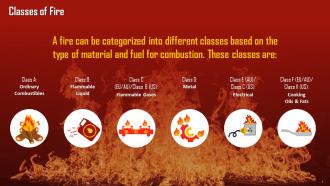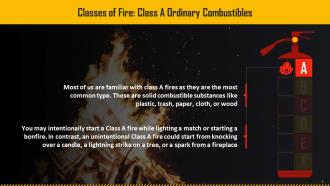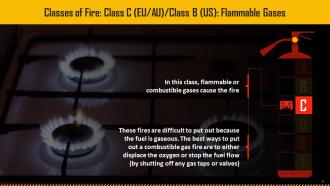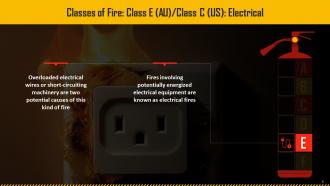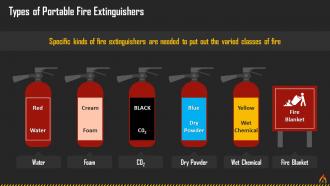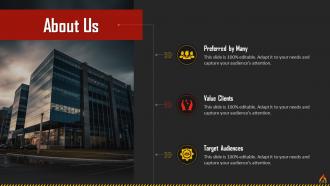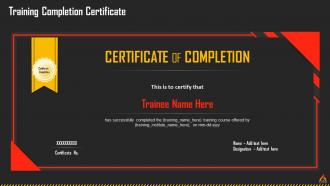A Comprehensive Guide To Classes Of Fire Training Ppt
This set of slides discusses the categorization of fires into various classes. The classes are as follows Class A Ordinary Combustibles, Class B Flammable Liquid, Class C EU or AU, Class B US Flammable Gases, Class D Metal, Class E AU, Class C US Electrical, and Class F EU or AU, Class K US Cooking oil and fats.
You must be logged in to download this presentation.
PowerPoint presentation slides
Presenting A Comprehensive Guide to Classes of Fire. These slides are 100 percent made in PowerPoint and are compatible with all screen types and monitors. They also support Google Slides. Premium Customer Support available. Suitable for use by managers, employees, and organizations. These slides are easily customizable. You can edit the color, text, icon, and font size to suit your requirements.
People who downloaded this PowerPoint presentation also viewed the following :
Content of this Powerpoint Presentation
Slide 1
This slide lists classes of fire. A fire can be categorized into classes based on the type of material and fuel for combustion. These are A, B, C (AU/EU)/ B (US), D, E (AU)/ C (US), and F (EU/AU)/ K (US).
Slide 2
This slide talks about Class A fires that consist of ordinary combustibles. Most of us are familiar with Class A fires as they are the most common type. Theses are solid combustible substances like plastic, trash, paper, cloth, or wood.
Slide 3
This slide talks about Class B fires that consist of flammable liquid. These fires follow the same fundamental fire tetrahedron as regular combustible fires (heat, fuel, oxygen, chemical reaction), except that the fuel in question is a flammable liquid like gasoline or natural gas
Slide 4
This slide talks about Class C (EU/AU)/Class B (US) fires that consist of flammable gases. These fires are difficult to put out because the fuel is gaseous. The best ways to put out a combustible gas fire are to either displace the oxygen or stop the fuel flow (by shutting off any gas taps or valves)
Instructor’s Notes: In the European/Australian system, fires involving flammable or combustible fuel are categorized as "Class C"; however, in the US system, flammable liquids and gases together are categorized as "Class B" fires
Slide 5
This slide talks about Class D fires that consist of metal. Combustible metals, particularly alkali metals like lithium and potassium, alkaline earth metals like magnesium, and Group 4 elements like titanium and zirconium, are involved in Class D fires
Instructor’s Notes: Metal fires are typically dangerous when metal is present as sawdust, machine shavings, or other metal "fines," which ignite more quickly than bigger blocks due to their higher surface area
Slide 6
This slide talks about Class E (AU)/ Class C (US) fires that involve electricity. Overloaded electrical wires or short-circuiting machinery are two potential causes of this kind of fire.
Instructor’s Notes: Firefighters who use water or other conductive materials to put out these fires risk serious injury because electricity can travel through the water to the firefighter's body and subsequently to the earth
Slide 7
This slide talks about Class F (EU/AU)/ Class K (US) fires that consist of cooking oils and fats. Although these fires are essentially a subclass of flammable liquid/gas fires, their unique characteristics, particularly their higher flash point, are considered significant enough for these to be categorized as a seperate class.
Slide 8
This slide highlights types of fire extinguishers. These are water, foam, carbon dioxide, dry powder, wet chemical, and a fire blanket.
Instructor’s Notes:
- Water: Water fire extinguishers are labelled red and are used for extinguishing Class A fires. They effectively put out fires caused by solid combustibles like wood, paper, and textiles
- Foam: Foam fire extinguishers come with a cream label and are highly effective in extinguishing Class A and Class B fires
- Carbon Dioxide: Carbon Dioxide fire extinguishers have a black label and were designed to extinguish flammable liquid fires; hence they have a Class B fire rating. They can also be used to put out electrical fires, as carbon dioxide is not a conductor, and these do not leave any toxic residue
- Dry Powder: Dry Powder fire extinguishers come with a blue label and can be used to extinguish Class A,B,C, and electrical fires
- Wet Chemical: Wet chemical fire extinguishers come with a yellow label and are designed specifically for extinguishing fires involving combustible cooking material such as burning oil and fat
- Fire Blanket: A fire blanket is a safety tool designed to put out incipient or developing fires. It consists of a sheet made of fire-resistant material that can be placed over a fire to smother it. In addition to being frequently used for chip pan and toaster fires, they can also be found in laboratories and waste bins
Slide 9
This slide depicts a fire classification and extinguisher table. It highlights types of fire extinguishers that can be used for putting out types of fires.
A Comprehensive Guide To Classes Of Fire Training Ppt with all 25 slides:
Use our A Comprehensive Guide To Classes Of Fire Training Ppt to effectively help you save your valuable time. They are readymade to fit into any presentation structure.
-
I am a big fan of their newsletters because that is how I found my perfect requirement at the time of urgency. Thank God, I kept opening those.
-
Excellent work done on template design and graphics.



























